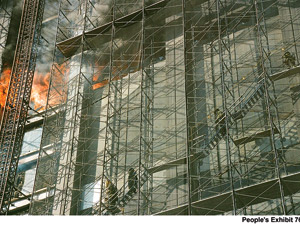On May 2, as the manslaughter trial of three construction firm managers in the fatal Ground Zero building fire entered its fifth week, 28 prosecution witnesses had been called and 78 more were set to testify. Citing the potential for redundant and irrelevant testimony and noting that jurors appeared fatigued, New York State Supreme Court Judge Rena K. Uviller ordered the prosecution to cut its witness list and rest its case by May 31.

The Aug. 18, 2007, fire at the former Deutsche Bank building killed firefighters Robert Beddia and Joseph P. Graffagnino. In the trial of the defendants—Jeffrey Melofchik, former building safety manager for general contractor Bovis Lend Lease, New York City; and Mitchel Alvo and Salvatore DePaola, former asbestos- abatement supervisors for the now-defunct subcontractor John Galt Corp.—testimony from construction, fire department and other site witnesses has centered on a standpipe in the building's basement. Prosecutors say cutting the pipe stopped water flow to the blaze and asbestos-containment barriers blocked firefighter access. Abatement and demolition of the 40-story high-rise, damaged on 9/11, was completed in January.
Prosecution testimony included accounts of unsafe sitework practices and conditions. “This does not mean that every unsafe situation is relevant to this trial,” Uviller said. “I've allowed testimony regarding cigarette smoking because that started the fire.” She declared as irrelevant testimony of on-site drinking and small fires that occurred during demolition. Uviller is adjudicating the Alvo and Galt cases. Melofchik and DePaolo are facing a jury verdict.
Arnel Javal, senior project manager for TRC, a Windsor, Conn., environmental firm on-site, testified in cross-examination that he knew—as did government inspectors—about sealed plastic barriers erected in stairwells for air monitoring. The barriers prevented firefighters from reaching the fire via interior stairways. He also said the basement work area in which the standpipe section had been cut was inspected three times in the months before the fire, but no regulator remarked on or recorded the condition of the standpipe.
Witnesses also testified that, to expedite abatement work, site officials gave orders to remove hangers supporting the standpipe and, later, to dismantle a section of the pipe itself.
Previous city Fire Dept. witnesses had testified there was no water flow reaching the 17th-floor site, but they acknowledged that poor communications delayed hose connections to outside sources for more than an hour.
Earlier, fire Capt. Steven Gentiluomo testified that firefighters were not informed of the barriers or how to remove them, forcing them to escape using outside scaffolding. They also were unaware of banks of fans—which had been used to create negative air pressure in the abatement process—that drew smoke from the fire down to the lower floors.



Post a comment to this article
Report Abusive Comment